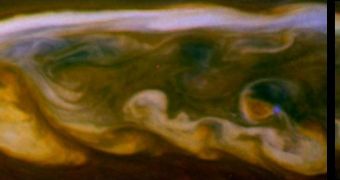Though it has been orbiting Saturn since July 1, 2004, the NASA Cassini space probe saw the most violent lightning storm in the gas giant's atmosphere only last year. The images to the left were collected on March 2, 2011.
The massive atmospheric event actually raged on throughout the planet's northern hemisphere for much of last year. This gave Cassini the opportunity to see lightnings occurring on the day side of the gas giant, not only its night side.
Previously, scientists thought that it was impossible for Saturnine lightnings to be observed in full daylight. But Cassini was able to create false-color images that reveal the existence of such lightning, depicted as the bluish bots in this photo.
Another amazing aspect of this type of observations is that experts now know for sure Saturnine lightnings occur in optical wavelengths. This is what happens on Earth, but there was no reason until now to believe that the same thing must be happening on the gas giant as well.
“We didn't think we'd see lightning on Saturn's day side – only its night side. The fact that Cassini was able to detect the lightning means that it was very intense,” NASA Jet Propulsion Laboratory (JPL) Cassini imaging team associate, Ulyana Dyudina, explains.
She holds an appointment as a researcher at the California Institute of Technology (Caltech), in Pasadena, California. The investigator explains that Cassini used the blue filter on its imaging camera to capture this image of the gas giant on March 6, 2011.
“Scientists are still analyzing why the blue filter catches the lightning. It might be that the lightning really is blue, or it might be that the short exposure of the camera in the blue filter makes the short-lived lightning easier to see,” a JPL press release reveals.
“As summer storm season descends upon Earth's northern latitudes, Cassini provides us a great opportunity to see how weather plays out at different places in our solar system,” JPL Cassini project scientist Linda Spilker says.
“Saturn's atmosphere has been changing over the eight years Cassini has been at Saturn, and we can't wait to see what happens next,” she adds.

 14 DAY TRIAL //
14 DAY TRIAL //